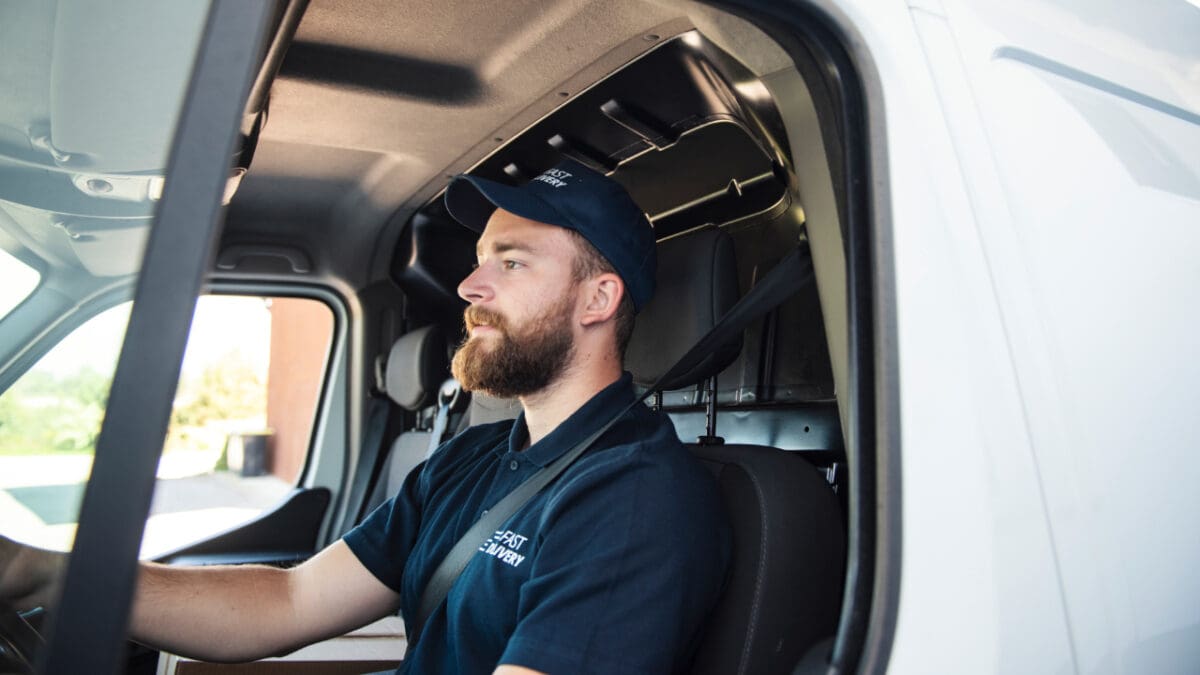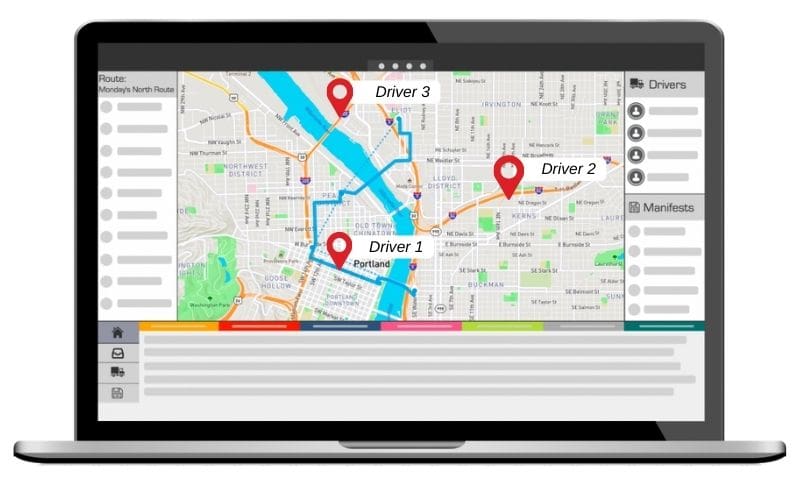
Driver tracking is a technology that monitors the movements of drivers using GPS technology installed in vehicles. With over 5.6 million commercial fleets in the logistics, courier, car rentals, taxi, and construction spheres already using the trackers to streamline logistics and fleet management, driver tracking has proven quite valuable.
Entities that have deployed driver tracking technology experience significant benefits, including reduced fuel costs, improved protection against false claims, reduced accident costs, and enhanced driver safety. Sound like something you might be interested in? Learn more about driver tracking and how the technology can streamline your fleet management below!
Why Should I Consider Driver Tracking?
There are several reasons why you should consider a dedicated driver tracker. Beyond mere supervision, driver tracking gives you insights to driver behavior, locations, and more. More specifically, you can experience these benefits:
1.) Stop Losing Time and Money on the Road
Some driving behaviors, like excessive idling, waste time and money. For instance, an 8,000 cc truck wastes around 0.8 liters of fuel idling for one hour. Thus, if you have a larger fleet of 8,000 cc trucks, you are likely to lose hundreds of liters each day.
Besides idling, companies waste several hours and dollars due to poor route planning. The wastage results from unnecessary mileage, which increases fuel costs, travel times, delivery timelines, and vehicle wear and tear.
Driver tracking can help you minimize resource wastage. In particular, driver tracking helps you analyze driver performance to identify areas of improvement. After that, your dispatchers can choose the proper routes to reduce mileage and fuel costs, which are the second leading expense in trucking.
Some tracking systems monitor a driver’s behavior in real time. With these tracking systems, you can identify risky driving practices, ranging from harsh braking to taking unapproved routes. By identifying these areas for improvement, you can take prompt action by increasing training and reducing the costs associated with these behaviors.

2.) Saving Dispatchers Time
Investing in a premium driver tracking system is one way to save time and streamline workflows in your dispatch department. With the tracking technology, your dispatchers can monitor routes for issues like traffic congestion or road closures.
Afterward, these service providers can advise drivers to reroute vehicles to an alternative road. The rerouting will not only save time but also minimize idle time, reduce fuel consumption, and maintain on-time delivery.
Furthermore, a good driver tracking system allows the dispatcher to have oversight of several drivers simultaneously. This enables the dispatchers to make quick decisions about new or updated orders coming in without having to waste time contacting each driver for updates.
3. Giving Customers Autonomy
Driver tracking isn’t solely beneficial for your business– its benefits extend to customers as well. Once you have reliable driver tracking in place, setting up a customer-friendly tracking page should be your next step. By enabling customers to look up and track their own orders, you give them autonomy to answer their own questions, create plans around their ETAs, which will ultimately improve their overall satisfaction.
Although we’re talking about the benefits to the customer here, this also turns into a win-win for you. By offering greater transparency with driver tracking, you are able to reduce the number of customer inquiries your team handles in a day. You can use the saved time to focus on other critical operations like market research and streamlining internal processes.
4.) Increasing Business Competitiveness
Competition is a constant for businesses offering transportation, logistics, and delivery services. Since you do not want to lose business to a competitor, a good driver tracker can give you an edge.
While all the aforementioned benefits play into the competitive edge (safer driving, greater transparency, etc), it is the small details that can add up. For example, accurate ETAs and real-time notifications can go a long way when fostering trust and customer experience. Driver tracking will position you as a customer-centric service provider worthy of buying from.
5.) Reducing Asset Theft
Driver tracking plays a crucial role in reducing theft by providing real-time visibility into the location and status of each delivery. With GPS tracking, businesses can monitor their vehicles throughout the entire delivery route, quickly identifying any unauthorized stops or deviations. This increased transparency deters potential theft and allows for immediate action if suspicious activity is detected. Additionally, the ability to track and record every movement creates a secure environment, giving both the business and the customer peace of mind.
I Want to Track My Drivers! What Do I Need?
To start tracking your drivers effectively, you’ll need three essential components: fleet telematics, tracking software, and a driver app. Here’s a detailed overview of how each of these systems contributes to vehicle tracking:
1.) Fleet Telematics
Fleet telematics is a technology that uses sensors and GPS to collect vital data from vehicles. This data typically includes the vehicle’s location, diagnostics, speed, and idle time. The information is then transmitted to your dispatch office, where it can be analyzed and utilized. With these insights, you can optimize routes, monitor driver behavior, and enhance overall fleet efficiency.
2.) Tracking Software
Tracking software enables dispatch teams to monitor a vehicle’s real-time location and other key metrics such as speed, idle time, route, and stoppage time. By providing real-time insights, this software allows fleet managers to oversee operations closely, identify areas for improvement, and make data-driven decisions that boost operational efficiency.
3.) Driver App
The driver app serves as a direct link between drivers and the tracking system. It provides drivers with the necessary information to optimize their routes and allows them to share trip details with dispatchers, log working hours, and request emergency assistance when needed. This app ensures that drivers are well-equipped and connected, further enhancing the effectiveness of fleet management.

How Does Tracking Work?
Although tracking may seem technical, its operation is relatively straightforward. A fleet management service provider will install GPS trackers or telematics devices in each vehicle within your fleet. Once installed, these devices enable you to monitor your vehicles in the following ways:
- Data Transmission: The GPS module and sensors in the tracking device gather a range of information, including vehicle location, driver behavior, and performance metrics. This data is then transmitted to your dispatch office in real time.
- Data Analysis: Fleet management software, equipped with advanced algorithms and analytics, processes the incoming data to generate actionable insights. This analysis covers aspects such as idle time, driver behavior, mileage, fuel consumption, and traffic conditions.
- Fleet Management: Armed with these insights, your fleet manager can make informed decisions to optimize operations. For example, if a particular route is congested, they can quickly reroute drivers to an alternative path, saving time, fuel, and costs.
- Driver Interface: Drivers receive updates and instructions from the dispatch team through a mobile app or in-vehicle device. This interface provides real-time information on route changes and navigation assistance, while also allowing drivers to communicate back and offer feedback.
FAQs For Driver Tracking
From understanding how driver tracking works to exploring its legal implications, it is normal to experience a couple of concerns when planning to invest in this system. Below, are the answers to some of the most commonly asked questions when it comes to driver tracking:
When Should I Consider Installing a Driver Tracking System in Our Fleet?
There’s no perfect time to invest in a driver tracking system, but many businesses choose to implement this technology when they want to optimize fleet management. Driver trackers provide real-time visibility into driver activities, allowing you to make proactive decisions that enhance overall operations.
By using a reliable tracking system, you can improve driver safety, optimize routes, and reduce delivery times. In turn, this can lead to increased customer satisfaction and fuel cost savings of up to 20%.
Which Industries Benefit Most from Driver Tracking?
While any business operating a fleet of vehicles can benefit from a driver tracking system, this technology is particularly valuable for industries that rely heavily on transportation and logistics. These include delivery services, transportation companies, and taxi operators.
These businesses often manage large fleets, making trackers essential for optimizing management. They invest in tracking systems to tackle challenges related to route optimization, fuel efficiency, and customer service, ultimately improving operational efficiency.
How Does a Driver Tracking System Enhance Safety?
A driver tracking system monitors critical driving behaviors such as speeding, harsh braking, and rapid acceleration. This data allows dispatchers and drivers to take corrective actions, promoting safer driving practices.
In the transportation sector, prioritizing driver safety not only reduces the risk of costly accidents, insurance claims, and legal liabilities but also enhances fleet efficiency by minimizing wear and tear-related downtime.
Is Driver Tracking Regulated by Law?
Yes, driver tracking is subject to legal regulations. Employers must inform drivers that their vehicles are equipped with tracking devices and obtain their consent. It’s crucial to conduct tracking in a manner that respects drivers’ privacy rights.
Additionally, tracking should be limited during off-duty hours. Look into the compliance and regulations for sensitive data and tracking in your area to ensure you are following code.
What Can I Track with a Driver Tracking System?
A driver tracking system allows you to monitor various aspects of driver behavior and vehicle performance in real time. Key data points include vehicle location, speed, and route history.
Advanced tracking systems can also capture additional metrics such as harsh braking, fuel consumption, and idle time, providing a comprehensive view of fleet operations.
How Accurate Are Driver Trackers?
Premium driver tracking systems are highly accurate, with advanced models capable of pinpointing a vehicle’s location within a one-meter radius. These trackers utilize sophisticated GPS technology and algorithms to ensure precise monitoring.
For example, GPS triangulation from multiple satellites provides accurate real-time location data, while additional sensors further enhance the system’s accuracy.

What Is the Cost of a Driver Tracking System?
The cost of installing a tracking system varies based on several factors, including the type of device, its features, and installation labor. Basic tracking devices are more affordable, while advanced systems offering real-time monitoring and driver behavior analysis are typically more expensive. For app-based tracking systems like a delivery driver app, the cost is minimal and requires little installation.
Can Drivers Tamper with a Tracking System
While it is technically possible for drivers to tamper with or disable tracking devices, such actions are usually detectable. Tamper alert systems are designed to send notifications to the dispatch team if any interference is detected.
What Are the Disadvantages of a Tracking System?
Despite the benefits, driver tracking systems do have some downsides. Privacy concerns are a major issue, as drivers may feel that constant monitoring is intrusive.
This can lead to decreased job satisfaction, reduced retention rates, and potential distrust between management and drivers. However, open communication can alleviate these concerns. By explaining the purpose of the tracking system, addressing privacy issues, and involving drivers in the decision-making process, you can foster a more positive attitude towards the technology.
Streamline Your Logistics With Elite EXTRA’s Tracking
When investing in driver tracking, choose a solution with comprehensive features. At a minimum, the ideal tracker should allow you to optimize routes, monitor driver behavior, enhance safety, and improve overall fleet efficiency. Elite EXTRA’s software is a trusted choice that delivers on all these fronts.
With Elite EXTRA, you gain access to a robust set of features designed to elevate fleet management. Our software helps businesses streamline routes, provide real-time customer notifications, and make informed, data-driven decisions. Trusted by over 325,000 users, our solution is proven to deliver results.
Schedule a demo today to learn more about the possibility of driver tracking for your operations.
Sources
https://gitnux.org/gps-tracking-industry
https://www.linkedin.com/pulse/idling-costly-fuel-wear-engine-life-thief-wearcheck-international-glbbf
https://www.cloudtrucks.com/blog-post/trucking-trends
https://www.semrush.com/blog/word-of-mouth-stats
https://www.linkedin.com/pulse/taming-fuel-consumption-tracking-hub-limited
https://oag.ca.gov/privacy/ccpa
https://www.expertmarket.com/uk/vehicle-tracking/accurate-gps-tracking







